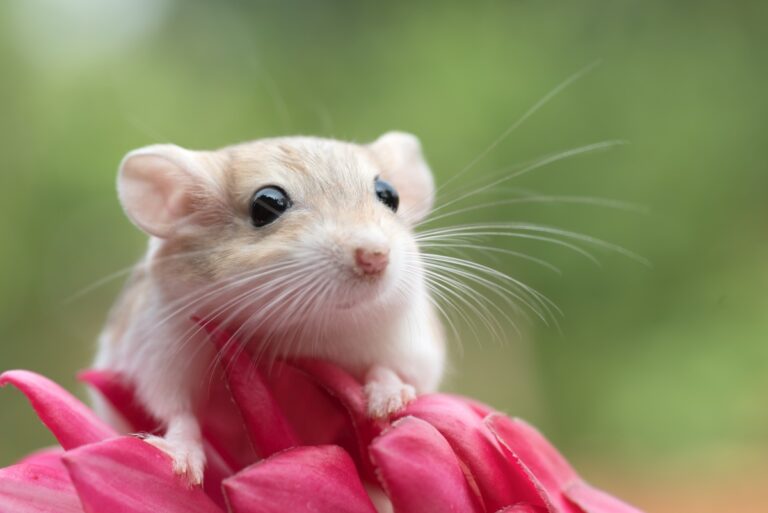The Essentials
No, while some mice, like house mice, can be pests in human dwellings, many mouse species play essential roles in ecosystems and are not considered pests. Read more.
Mice are used in research due to their genetic similarity to humans, making them valuable for studying genetics, diseases, and pharmaceutical testing. Read more.
Preventing mouse infestations can be achieved by sealing entry points, maintaining cleanliness, and storing food in airtight containers. Read more.
The mouse is an incredibly small animal many people are afraid of. Mice, those small, unassuming creatures that scurry around our homes and fields, have a far more intricate and intriguing existence than we might imagine.
These tiny rodents play vital roles in ecosystems, have remarkable adaptations, and even hold a significant place in human history. Join us as we delve into the captivating world of mice, from their diverse species to their unique behaviors and contributions to science.
The Diversity of Mice

Mice come in various shapes, sizes, and colors, making them a diverse group of rodents. House mice (Mus musculus) are the most common, known for their adaptability to human environments. They are small, typically gray or brown, and have a keen sense of hearing.
Field mice (Apodemus spp.) encompass various species with different distributions, each uniquely adapted to life in the wild. Harvest mice (Reithrodontomys spp.) are the world’s smallest rodents, known for their agility and distinctive nesting behavior.
Tip: Preventing mouse infestations is often more effective than dealing with them once they’re established. Seal any cracks or holes in your home’s foundation and walls, keep food stored in airtight containers, and maintain cleanliness in and around your living spaces. These simple steps can go a long way in deterring mice from making your home their own.
Mouse Adaptations
Mice have evolved numerous adaptations that allow them to thrive in various environments. They are primarily nocturnal creatures, well-suited for nighttime activity with excellent night vision and acute senses.
Whiskers play a crucial role in sensing their surroundings, aiding in navigation and predator evasion. Mice are also highly social creatures, communicating through vocalizations, body language, and scent marking, which helps establish social hierarchies and facilitates mating rituals.
Advice: Consider nature’s pest control – attracting natural predators like owls, snakes, and domesticated cats can help keep mouse populations in check around your property. Installing owl nesting boxes or encouraging the presence of these natural hunters can be an eco-friendly and effective way to manage mice without resorting to chemicals or traps.
Mice and Human History
Mice have been closely intertwined with human history for thousands of years. On one hand, they’ve been a significant pest, impacting agriculture and food storage. Throughout history, humans have employed various methods to control mouse infestations. Notable historical instances include devastating mouse plagues that caused widespread damage.
On the other hand, mice have played a crucial role in scientific research. They are indispensable in medical and genetic studies, contributing significantly to our understanding of genetics, diseases, and behavior. However, ethical considerations and animal welfare in research are of paramount importance, and guidelines have been established to ensure humane treatment.
Mice have also left their mark in popular culture, with beloved cartoon and literary characters featuring these tiny rodents. They have found a place in folklore and cultural symbolism, often representing various qualities and concepts. Additionally, domesticated mice are kept as pets, offering companionship to many enthusiasts.
Warning: While poison baits may seem like a quick solution to a mouse problem, they come with significant risks. Poisoned mice can die in hard-to-reach places, causing unpleasant odors and attracting other pests. Moreover, these toxins can harm pets and children if ingested accidentally. Consider humane traps or consulting with a pest control professional as safer alternatives.
Conservation and Ethical Considerations
While some mice are considered pests, others face threats to their populations. Conservation efforts are in place to protect specific mouse species and maintain ecosystem balance. These efforts aim to address the challenges these creatures face in their natural habitats.
Ethical considerations surrounding the treatment of mice are essential, particularly in scientific research and as pets. Guidelines and regulations exist to ensure their humane treatment, and various organizations are dedicated to advocating for mouse welfare and promoting ethical practices.
Additional Information: When mice find their way into your home, they can pose health risks and damage property. Look for signs such as gnawed wires, droppings, or squeaking sounds. If you suspect a mouse infestation, it’s essential to address it promptly to prevent further problems.
Mice as Disease Vectors
Mice can have significant implications for public health due to their role as disease vectors. These rodents can carry various pathogens and parasites that pose risks to humans and other animals. Some of the diseases associated with mice include hantavirus, leptospirosis, and Lyme disease. Understanding how mice contribute to the transmission of these diseases is crucial for prevention and control efforts.
Gerbil
A gerbil is a small rodent belonging to the subfamily Gerbillinae. They are similar in size and appearance to mice but are typically characterized by long tails, large eyes, and a hopping gait. Gerbils are known for their sociable nature and are commonly kept as pets due to their friendly disposition.
Mice in Art and Literature
Mice have not only left their mark in popular culture but have also inspired countless artists and writers throughout history. Mice have been used as symbols and metaphors in literature and art, representing various themes such as innocence, vulnerability, and resourcefulness.

Small, but impressive!
Mice may seem small and unassuming, but they are essential components of ecosystems, subjects of scientific study, and even characters in our cultural narratives. From their diverse species and fascinating adaptations to their historical significance and ethical considerations, mice continue to capture our interest and play critical roles in our world. The more we learn about these tiny wonders, the more we appreciate their place in the intricate tapestry of life on Earth.



